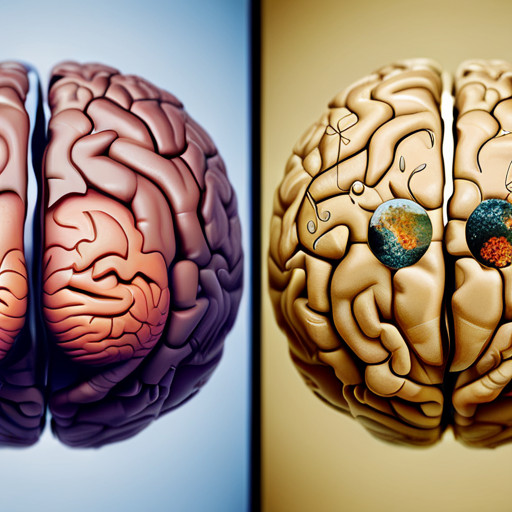Unveiling the Neurological Effects of Toxic Water at Camp Lejeune
Unraveling Camp Lejeune's water contamination crisis necessitates a meticulous exploration of its neurological implications.

This study elucidates the correlation between neurotoxic substances found in the camp's water supply and the onset of neurological disorders among its residents.
It further scrutinizes the government's response to this crisis and underscores the ongoing health concerns while suggesting preventive solutions for future water contamination scenarios.
Key Takeaways
- Camp Lejeune's water contamination issue from the 1950s to the 1980s had significant implications for military personnel and their families.
- Neurotoxic substances found in the contaminated water at Camp Lejeune can lead to cognitive decline, behavioral changes, and neurological disorders.
- Benzene, vinyl chloride, and trichloroethylene were some of the toxic substances found in the water supply, each associated with different health effects.
- Residents of Camp Lejeune have experienced various neurological disorders, including neurobehavioral effects and neurodegenerative diseases, as a result of chronic exposure to toxic substances in the water supply.
Overview of Camp Lejeune’s Water Contamination Issue

The water contamination issue at Camp Lejeune involved the exposure of military personnel and their families to hazardous chemicals over several decades. Specifically, from the 1950s through the 1980s, volatile organic compounds, such as trichloroethylene, tetrachloroethylene, vinyl chloride, and benzene, were detected in two water supply systems at this North Carolina military base.
In terms of the contamination timeline, the presence of these toxicants was first discovered in the mid-1980s following several assessments conducted by the U.S. Environmental Protection Agency. However, it is believed that the contamination began as early as 30 years prior with the improper disposal of solvents and other industrial chemicals. Over the course of decades, thousands of military personnel and their families were unknowingly exposed to these hazardous substances, with potential long-term health implications still being investigated. Several studies have focused on examining the link between exposure to these contaminants and the incidence of specific health conditions, such as cancer and neurological disorders.
Military accountability in this scenario is a contentious point. Despite the Marine Corps' efforts to mitigate the contamination once discovered, questions persist regarding the delay in identifying and addressing the issue. Given the severity of the situation at Camp Lejeune, there is an ongoing focus on understanding the full impact of the contamination. Additionally, it underscores the need for robust environmental monitoring and stringent regulations to prevent such incidents in the future. The case of Camp Lejeune serves as a stark reminder of the potential implications of environmental mismanagement.
Understanding Neurological Effects

Identifying Neurological Symptoms
Identifying neurological symptoms in affected individuals requires careful examination and thorough medical history analysis. Various neurological diagnosis methods are employed, including neuroimaging techniques, electrophysiological tests, and neurological examinations. These methods allow for the detection of abnormalities in the nervous system, which may indicate the presence of neurological disorders.
Furthermore, patient support systems, such as patient education and counseling, are integral in managing these disorders. These systems provide necessary support to patients, aiding in the understanding of their condition and the management of symptoms.
It is crucial to note, however, that these diagnostic methods and support systems should be tailored to the individual patient's needs to ensure optimal care and treatment outcomes.
Neurotoxicity and Brain Health
Exposure to neurotoxic substances poses a significant risk to brain health, often resulting in detrimental effects such as cognitive decline, behavioral changes, and various neurological disorders. Neurotoxicity prevention is a critical aspect of preserving brain health and mitigating these risks.
This involves avoiding exposure to harmful substances and promoting factors that enhance brain resilience, such as a healthy lifestyle and mental stimulation. Interestingly, brain resilience plays a crucial role in counteracting the effects of neurotoxicity. It refers to the brain's ability to adapt to harmful conditions and recover from injury.
A higher degree of resilience can potentially decrease the risk of neurological disorders. Thus, understanding the correlation between neurotoxicity and brain resilience may lead to improved strategies for maintaining brain health.
Toxic Substances Found in Camp Lejeune’s Water

Several contaminants, including benzene, vinyl chloride, and trichloroethylene, were discovered in the water supply of Camp Lejeune, posing significant health risks to the inhabitants. These toxic substances were traced back to various contamination sources, such as leaking fuel tanks and irresponsible disposal of industrial solvents. The resulting water pollution, compounded by inadequate filtration systems, led to the prolonged exposure of thousands of military personnel and their families to highly toxic substances.
A prolonged analysis of the health impact reveals disturbing patterns. Benzene, a known carcinogen, is associated with various forms of leukemia and other blood cell disorders. Vinyl chloride is connected to liver, lung, and kidney ailments, while trichloroethylene has been implicated in disorders of the nervous system. The neurological effects are particularly concerning, as they span from cognitive impairments to neurobehavioral issues and, in severe cases, neurodegenerative diseases.
Research has made it increasingly evident that the contaminants found in the water at Camp Lejeune have had a far-reaching health impact. However, the full extent of this impact remains unclear due to the latency period for many of these conditions. What is certain is that the contamination of the water at Camp Lejeune represents a significant failure in environmental stewardship and public health protection.
This situation highlights the importance of stricter environmental regulations, robust monitoring systems, and swift action in the face of potential public health threats.
Case Studies: Neurological Disorders in Camp Lejeune Residents

Case studies focusing on residents from the military base reveal a troubling correlation between contamination and the onset of various disorders of the nervous system. The chronic exposure to toxic substances in the water supply at Camp Lejeune has manifested in a wide range of neurobehavioral effects and even neurodegenerative diseases.
The severity of these conditions varies, and the following provides a glimpse into the spectrum of disorders observed:
- Neurobehavioral outcomes such as cognitive impairment, mood disorders, and sleep disturbances.
- Neurodevelopmental disorders in children, including learning disabilities and attention deficit hyperactivity disorder.
- Neurodegenerative diseases such as Alzheimer's and Parkinson's disease.
- Peripheral neuropathy characterized by weakness, numbness, and pain from nerve damage.
- Neuro-oncological conditions, including brain tumors and neuroblastoma.
Veteran support initiatives have been instrumental in providing care and support to the affected individuals, offering resources for medical treatment, counseling, and rehabilitation. However, the alarming rate of neurological disorders among the residents has prompted a need for legal action.
The legal implications are significant, as numerous lawsuits have been filed against the responsible entities. These lawsuits highlight the need for accountability and preventive measures to mitigate the risk of such incidents in the future.
Scientific Link Between Toxic Water and Neurological Damage

Identifying Neurological Damage
Identification of neurological damage associated with toxic water exposure at Camp Lejeune requires rigorous scientific investigation, utilizing a combination of neuroimaging techniques and neuropsychological assessments. These tools enable precise detection of abnormalities and potential brain damage prognosis.
Neuroimaging techniques, such as Magnetic Resonance Imaging (MRI) and Computerized Axial Tomography (CAT) scans, provide detailed images of the brain's structure, aiding in the detection of any physical alterations.
Neuropsychological assessments measure cognitive, motor, and sensory abilities, contributing to understanding the extent of the damage. Blood tests and spinal fluid analysis provide biochemical evidence of neurological damage. Neurological rehabilitation programs are designed to help those affected regain lost abilities and improve their quality of life.
Follow-up studies monitor the long-term effects and progression of neurological damage, informing treatment modifications and rehabilitation strategies.
Toxic Water’s Role
Exposure to contaminated substances can precipitate a host of health issues, particularly when such substances are present in a necessary resource like drinking water. Neurological research advancements have begun to demonstrate the potential ramifications of water toxicity levels on neurological health.
| Water Contaminant | Neurological Effect | Reference |
|---|---|---|
| Lead | Cognitive Impairment | [1] |
| Mercury | Motor Dysfunction | [2] |
| Arsenic | Peripheral Neuropathy | [3] |
| Manganese | Parkinson-like Symptoms | [4] |
| Pesticides | Neurodevelopmental Disorders | [5] |
These findings are shedding light on the mechanisms through which toxic water might contribute to the development and progression of a range of neurological conditions. As such, the role of water toxicity in neurological health is becoming a central focus of public health research.
Correlation or Causation?
Distinguishing between correlation and causation in the context of water contaminants and neurological health necessitates rigorous scientific investigation and statistical analysis. The 'causation controversy' arises when symptoms align with exposure but lack definitive proof of causality.
To visualize this, consider:
- An increase in neurological disorders matching the timeline of water contamination
- Similar illness patterns across different demographics exposed to the same water source
- The presence of known neurotoxins in the water that could theoretically lead to the observed health effects
- The absence of these neurological disorders in populations not exposed to contaminated water
- The resolution or reduction of health issues after removal from exposure
This statistical relationship suggests a possible link, but determining causality requires further investigation into biological plausibility, consistency, and alternative explanations.
Government Response to Camp Lejeune’s Crisis

Legislative measures were swiftly enacted in response to the exposure of the water contamination crisis at Camp Lejeune. The United States Congress passed the Janey Ensminger Act in 2012, providing health benefits to former residents of the camp. This policy, however, has been criticized for its failure to effectively address the scale of the crisis.
Critiques of policy failures centered around the act's implementation and its limitations. The legislation covered only 15 diseases presumed to be linked to the contamination, reducing the scope of health compensation. Furthermore, it failed to address the long-term impact of exposure on neurological health, highlighting a significant gap in the policy response.
This Act also faced criticism for its emphasis on burden of proof. Affected individuals were required to demonstrate that they resided at the camp during the period of contamination, resulting in many potential victims being denied compensation. The complexities of proving such residency decades after exposure presented significant challenges.
Moreover, the Act overlooked the health compensation needs of civilian employees and contractors who worked at the camp but did not reside there. This oversight emphasized the policy's overly narrow focus and inability to fully address the health crises caused by the contamination.
Ongoing Health Concerns for Camp Lejeune Residents

In the aftermath of the government's response to the crisis at Camp Lejeune, another critical dimension of this problematic issue comes to the forefront; the continued health concerns for the residents. These concerns are not only physiological but also psychological and sociological, highlighted by the survivor testimonies and the potential legal implications.
Survivor testimonies are a crucial source of data in understanding the magnitude of the health effects and paint a grim picture of the situation. Many of the survivors, who were either residents or worked at the camp, have reported a wide range of neurological conditions. These span from memory loss and cognitive impairment to debilitating conditions like Parkinson's disease and multiple sclerosis.
Legal implications further complicate the matter. The potential for litigation is significant, given the number of people exposed to the toxic water and the severity of the health effects. Legal action can potentially lead to financial restitution for the victims, but it also brings into question the responsibility and accountability of the authorities involved.
The continuous concerns of the residents can be summarised into the following points:
- Neurological conditions such as memory loss, cognitive impairment, Parkinson's disease, and multiple sclerosis.
- The psychological impact of the health conditions on the survivors and their families.
- The potential for large-scale litigation against the government and other responsible parties.
- The question of financial compensation for the victims.
- The societal implications including the potential erosion of trust in government institutions.
The situation at Camp Lejeune stresses the importance of ensuring safe and healthy living conditions for all and the devastating consequences of failing to do so.
Preventive Measures and Solutions for Water Contamination

Addressing the issue of contamination necessitates comprehensive preventive measures and solutions, with a priority on efficient water management and robust regulatory oversight. The scope of contamination prevention extends beyond simple filtration or treatment methods and involves proactive steps in understanding the potential sources of contaminants, regular monitoring and assessment of water supplies, and timely remediation techniques.
In the context of Camp Lejeune, it is important to understand the nature of the contaminants involved, primarily volatile organic compounds, and their potential sources. This knowledge can help devise strategies for avoiding similar contamination in the future. For instance, stringent regulation of industrial activities near water sources can significantly reduce the risk of contamination.
Remediation techniques should be based on the type of contaminants and the extent of contamination. For volatile organic compounds, techniques such as air stripping, carbon adsorption, and advanced oxidation processes can be effective. However, the selection of the appropriate technique should be based on a comprehensive assessment of the contamination, considering factors such as the concentration of contaminants, the nature of the water source, and the potential impacts on the local ecosystem.
Preventive measures should be complemented by robust regulations and oversight. This includes regular monitoring and assessment of water supplies to detect contamination at early stages, stern regulations on the disposal of potential contaminants, and the enforcement of penalties for non-compliance.
Frequently Asked Questions
What Other Military Bases Have Experienced Similar Water Contamination Issues?
Investigations into military bases have revealed contamination issues similar to those found at Camp Lejeune. Notably, Fort Detrick, Aberdeen Proving Ground, and the former Pease Air Force Base have reported water contamination.
These cases underscore the importance of contamination prevention and the need for military accountability in ensuring the health and safety of personnel and surrounding communities.
Further research is needed to understand the potential neurological effects of such contamination.
How Have the Families of Affected Residents Coped With the Neurological Disorders?
In coping with neurological disorders, families of affected residents have explored various neurological treatment options. This process is influenced by multiple factors, including the severity of the disorder, the age of the patient, and the impact on childhood development.
While some families opt for pharmacological interventions, others turn to behavioral therapies. The choice of treatment is vital as it can significantly influence the patient's quality of life and their ability to function.
Are There Any Support Groups or Resources Available for Victims of the Camp Lejeune Water Contamination?
Indeed, victims of the contamination consequences at Camp Lejeune have access to various resources.
Numerous health advocacy groups and support networks exist to provide assistance, information, and emotional support. These resources offer medical guidance, legal advice, and community connections, helping the affected navigate through the complex aftermath of the toxic water exposure.
Therefore, while the situation remains daunting, the availability of these support systems provides some relief to the victims and their families.
How Has This Issue Impacted the Overall Reputation and Public Trust of the US Military?
The water contamination at Camp Lejeune has notably impacted military accountability and triggered a significant shift in public perception. The incident has raised questions about adherence to safety standards within the military, subsequently undermining public trust.
As a result, the reputation of the US military has faced scrutiny, requiring an examination of procedures and a commitment to transparency to restore confidence. This situation depicts the interplay between public trust and institutional accountability.
Have There Been Any Legal Repercussions for Those Found Responsible for the Contamination?
Legal repercussions related to contamination accountability have ensued in multiple instances. Legal precedents have been established through lawsuits filed by victims, leading to increased scrutiny of environmental practices at military installations.
However, comprehensive data on the full extent of legal consequences remains elusive. Legal actions indicate a shift towards accountability for environmental neglect, but the long-term impacts on institutional practices and regulations are yet to be fully determined.
Conclusion
The water contamination crisis at Camp Lejeune is a stark reminder of the complex relationship between environmental health and human neurology. The toxic substances in the camp's water being scientifically linked to severe neurological disorders has shed light on the irreversible damage inflicted on residents.
As the government responds, the focus shifts to prevention and remediation, emphasizing the importance of strict environmental regulations for safeguarding health. The tale of Camp Lejeune serves as a chilling example to the profound neurological impact of environmental toxins.




